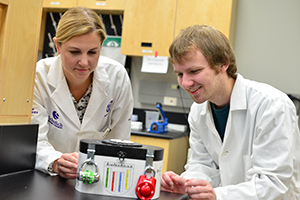An innovative approach to teaching teamwork
By Crystal Mackay, MA'05
 At first
At first
The ‘escape box’ was developed by Nicole Campbell,
It functions in much the same way as a mystery escape room - with a series of riddles and questions needing to be solved in order to get to the end. The intention is to bring fun and engagement to science-based learning, but most importantly, to help the students learn about how they work in teams.
“What interested me in this project was my love of teaching,” said Kelly. “I was really captivated by this because teamwork is often not given enough emphasis in undergraduate teaching, and developing a project that would help students see its importance was a really unique opportunity.”
Kelly helped develop the boxes but is also working with Campbell on a research project studying how they can be used effectively in an educational setting.
“The students were engaged, they were laughing, they were struggling, they sometimes needed hints,” said Campbell. “And at the end of the activity, we had a debrief where we asked them what messages about teamwork were embedded into the boxes.”
Campbell says when creating effective teams, having a diversity of skills is critically important. She and Kelly used the data gleaned from the debrief surveys to gather key information about these diverse skills.
“The aim of the survey was to see if we could dig in and get students to reflect on their own behaviours as a way to create diversity in groups,” Campbell said. The students were then put into their lab teams based on the diversity of teamwork skills. The research team will re-evaluate at the end of the term to see if it was an effective tool to help create diverse groups.
BMSc student Marwan Ahmed was one of the first in the class to get a crack at the escape box. What resonated with him was the attention that it brought to how different people approach the same problem.
“It provided insight into how different people learn and perceive information,” he said. “There were times that everyone had a different idea, and all the ideas made sense in their own way, so we could observe how each of us grasps a problem differently when it is presented in a specific way.”
Campbell and Kelly now hope to expand the boxes to be applicable to students beyond science.
“I think one of the unique things about this is that you can take this type of activity and apply it to any range of contexts,” Kelly said.








